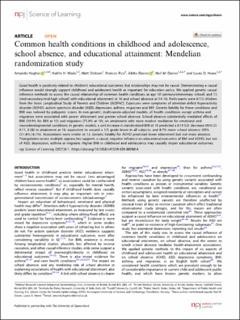| dc.contributor.author | Hughes, Amanda | |
| dc.contributor.author | Wade, Kaitlin H | |
| dc.contributor.author | Dickson, Matt | |
| dc.contributor.author | Rice, Frances | |
| dc.contributor.author | Davies, Alisha R. | |
| dc.contributor.author | Davies, Neil Martin | |
| dc.contributor.author | Howe, Laura D. | |
| dc.date.accessioned | 2022-11-18T07:36:34Z | |
| dc.date.available | 2022-11-18T07:36:34Z | |
| dc.date.created | 2021-09-28T13:16:44Z | |
| dc.date.issued | 2021 | |
| dc.identifier.citation | npj Science of learning. 2021, 6 (1), . | en_US |
| dc.identifier.issn | 2056-7936 | |
| dc.identifier.uri | https://hdl.handle.net/11250/3032695 | |
| dc.description.abstract | Good health is positively related to children’s educational outcomes, but relationships may not be causal. Demonstrating a causal influence would strongly support childhood and adolescent health as important for education policy. We applied genetic causal inference methods to assess the causal relationship of common health conditions at age 10 (primary/elementary school) and 13 (mid-secondary/mid-high school) with educational attainment at 16 and school absence at 14–16. Participants were 6113 children from the Avon Longitudinal Study of Parents and Children (ALSPAC). Exposures were symptoms of attention-deficit hyperactivity disorder (ADHD), autism spectrum disorder (ASD), depression, asthma, migraines and BMI. Genetic liability for these conditions and BMI was indexed by polygenic scores. In non-genetic, multivariate-adjusted models, all health conditions except asthma and migraines were associated with poorer attainment and greater school absence. School absence substantially mediated effects of BMI (39.9% for BMI at 13) and migraines (72.0% at 10), on attainment with more modest mediation for emotional and neurodevelopmental conditions. In genetic models, a unit increase in standardized BMI at 10 predicted a 0.19 S.D. decrease (95% CI: 0.11, 0.28) in attainment at 16, equivalent to around a 1/3 grade lower in all subjects, and 8.7% more school absence (95% CI:1.8%,16.1%). Associations were similar at 13. Genetic liability for ADHD predicted lower attainment but not more absence. Triangulation across multiple approaches supports a causal, negative influence on educational outcomes of BMI and ADHD, but not of ASD, depression, asthma or migraine. Higher BMI in childhood and adolescence may causally impair educational outcomes. | en_US |
| dc.language.iso | eng | en_US |
| dc.publisher | Springer Nature | en_US |
| dc.rights | Navngivelse 4.0 Internasjonal | * |
| dc.rights.uri | http://creativecommons.org/licenses/by/4.0/deed.no | * |
| dc.title | Common health conditions in childhood and adolescence, school absence, and educational attainment: Mendelian randomization study | en_US |
| dc.title.alternative | Common health conditions in childhood and adolescence, school absence, and educational attainment: Mendelian randomization study | en_US |
| dc.type | Peer reviewed | en_US |
| dc.type | Journal article | en_US |
| dc.description.version | publishedVersion | en_US |
| dc.source.volume | 6 | en_US |
| dc.source.journal | npj Science of learning | en_US |
| dc.source.issue | 1 | en_US |
| dc.identifier.doi | 10.1038/s41539-020-00080-6 | |
| dc.identifier.cristin | 1939782 | |
| dc.relation.project | Norges forskningsråd: 295989 | en_US |
| cristin.ispublished | true | |
| cristin.fulltext | original | |
| cristin.qualitycode | 1 | |

